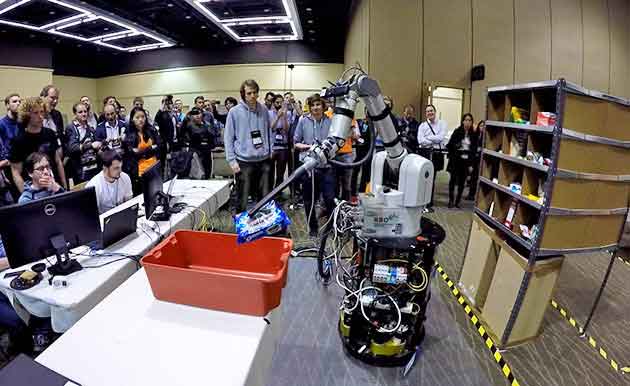From SCDigest's On-Target E-Magazine
- June 1, 2015 -
Supply Chain News: Amazon Comes Up with New Way to Innovate - Let the Grad Students Figure It Out for Almost Free
First Amazon Picking Challenge Sees 28 Robot Entries from Around the Globe, but Many Say Prize Money Needs Jacked to Come Back Next Year
SCDigest Editorial Staff
The innovation machine that is Amazon.com came up with a new way to find innovated ideas, sponsoring what it called the "Amazon Picking Challenge," a contest it announced last year that just completed its inaugural event in Seattle last week.
With existing its Kiva Systems robots (in place through an acquisition of the company in 2012), Amazon says that its "automated warehouses are successful at removing much of the walking and searching for items within a warehouse."
SCDigest Says: |
 |
| For humans, determining how to best grab items is second nature. But at the moment it's a big challenge for a robot. |
|
What Do You Say?
|
|
|
|
However, "commercially viable automated picking in unstructured environments still remains a difficult challenge," the company says on the contest web site, noting its contest was designed to spur improved capabilities in this area.
The Amazon contest was held in conjunction with IEEE's International Conference on Robotics and Automation in Amazon's home town of Seattle.
The competition asked contestants to build their own robot hardware and software to attempt simplified versions of the general task of picking items from shelves. The robots were presented with a stationary shelf holding items including a rubber duck, a pack of Oreo cookies, dog toys, pencils and a paperback book. The robots were asked to pick a subset of the products on the shelf and put them on a nearby table, as shown in the photo below.
The challenge combined the need for object recognition, pose recognition, grasp planning, compliant manipulation, motion planning, task planning, task execution, and error detection and recovery, Amazon said. In the end, each robot was asked to pick the same 12 items from the shelf and place them into a tote on the table.
Contestants were allowed to either build their own hardware and software systems, or acquire at no charge a "platform" to work with from leading robotics vendors such as Rethink Robotics, Clearpath, Fanuc and others (the number of free platforms was limited). Amazon hasn't released information on which teams used what hardware platforms.
For humans, determining how to best grab items is second nature. But at the moment it's a big challenge for a robot, and they can easily become confused. In general, the issues as much of a software problem as a hardware one, though there are some hardware challenges too.
Teams received full points for successfully moving each item from shelf to tote, and partial points if they picked up an item but subsequently dropped it or misplaced it on the table.

A team from Technical University of Berlin won the contest using a vacuum-powered robot successfully grabbing 10 out of the 12 items - in about 20 minutes.
(Distribution/Materials Handling Story Continues Below
)
|